How to Spend 7 Days in Malta: A Complete Itinerary
Last Updated: Jan 27, 2024
Reading Time: 21 minutes
By: Shaun
Malta is a small country, with a rich history, culture, and natural beauty. It has been influenced by various civilizations, from the Phoenicians to the British, and has a unique identity and charm. Malta is also home to some of the oldest and most impressive megalithic temples in the world, as well as stunning fortifications, churches, and museums. Malta’s sister island, Gozo, offers a more rural and tranquil escape, with its green hills, rugged coastlines, and quaint villages.
If you are planning to visit Malta, we suggest that you plan to stay for 7 days, as this will give you ample time to cover the highlights of Malta with a taste of Gozo as well. A week will also fit nicely when looking for flights to and from the islands, as most airlines operate on at least a weekly basis, with many operating more frequently and even daily during the summer months.
This post gives you a starting point to create your own itinerary based on your preferences, interests, and budget. We will provide links to other pages that delve deeper into each attraction and topic. So without further ado, let’s start discovering how to spend 7 days in Malta.
Day 1: Explore the capital city of Valletta

Triton Fountain | Image by Diego Delso on Wikimedia Commons
Irregardless of how long you will be staying in Malta, a visit to Valletta is a must on any itinerary. Valletta is a UNESCO World Heritage Site and has a rich and diverse heritage that spans over 500 years. Valletta is also one of the smallest and most densely populated capital cities in the world, with a lot to see and do in a compact area.
Here are some of the highlights of Valletta:
Visit St. John’s Co-Cathedral and the Grand Master’s Palace

The Grandmaster's Palace | Image by M W from Pixabay
These are two of the most important and impressive buildings in Valletta, built by the Knights of St. John, who ruled Malta from 1530 to 1798. The co-cathedral is a masterpiece of baroque art and architecture, with a lavish interior that features marble tombs, frescoes, and paintings by Caravaggio.
The newly restored palace was the residence and seat of power of the Grand Masters and now houses the President’s office. You can admire the state rooms, the armoury, and the tapestries that depict the history of Malta.
Stroll and have lunch at the Valletta Waterfront
The Valletta waterfront is a lively and picturesque area where you can see the colourful boats, the historic buildings, and the modern cruise terminal.
You can also find a variety of restaurants at the Valletta Waterfront, serving all sorts of cuisines. Try to get a table with a view of the harbour, and enjoy the fresh seafood and the local wine.
Enjoy the views from the Upper Barrakka Gardens and the Siege Bell War Memorial
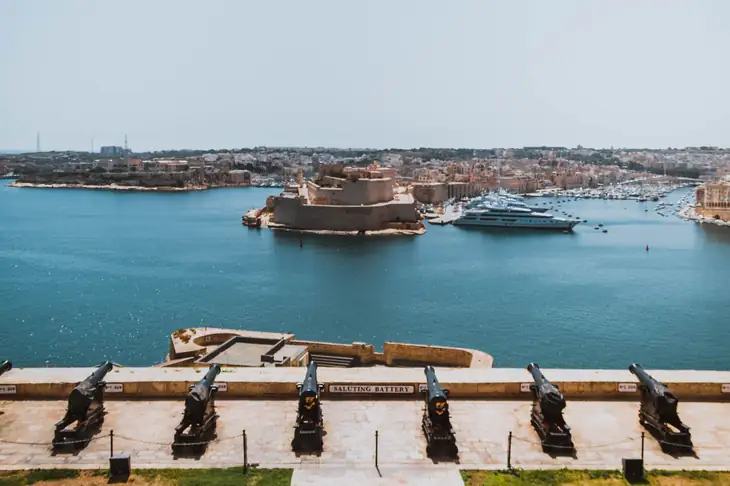
The Grand Harbour from the Upper Barrakka Gardens | Image by Kristina Paukshtite from Pexels
The Upper Barrakka Gardens are the highest point of the city walls and offer a panoramic view of the Grand Harbour and the Three Cities. A photo of the view from the Upper Barrakka Gardens is a must-take for any visitor who travels to Malta.
The Siege Bell War Memorial is a monument that commemorates the heroism of the Maltese people during the Second World War, when Malta was heavily bombed by the Axis powers. The bell rings every day at noon.
Discover the National Museum of Archaeology and MUZA

Sleeping Lady at the National Museum of Archaeology | Image by Jean-Pierre Dalbéra on Flickr
The National Museum of Archaeology is housed in a former Auberge of the Knights of St. John, coming from the region of Provençe. The museum displays a collection of artefacts that date back to the prehistoric and classical periods of Malta. You can see the famous figurines of the Sleeping Lady and the Venus of Malta, as well as pottery, tools, and jewellery.
The MUZA is the new national art museum, located in another Auberge, this time used by the knight from Italy. It showcases the artistic heritage of Malta, from mediaeval times to contemporary times, with works by local and international artists.
Watch the multimedia show at the Malta Experience
The Malta Experience is a 45-minute audiovisual presentation that narrates the history of Malta, from its origins to the present day. You can learn about the different cultures and events that shaped the island, such as the Great Siege, the French occupation, and the Independence.
The show is available in 17 languages and is a great way to get an overview of Malta’s past and present.
Day 2: Experience the Mediaeval Charm of Mdina and Rabat

Mdina Main Gate | Image by Andrey Sulitskiy on Flickr
Mdina and Rabat are two of the oldest and most charming towns in Malta, located in the central region of the island. Mdina was the former capital of Malta until the arrival of the Knights of St. John, who eventually moved the seat of power to Valletta. Mdina is also known as the Silent City because of its quiet and serene atmosphere and its narrow and winding streets.
Rabat is the suburb of Mdina and has a more lively vibe with its markets, churches, and catacombs.
Here are some of the highlights of Mdina and Rabat:
Stroll through the narrow roads of Mdina
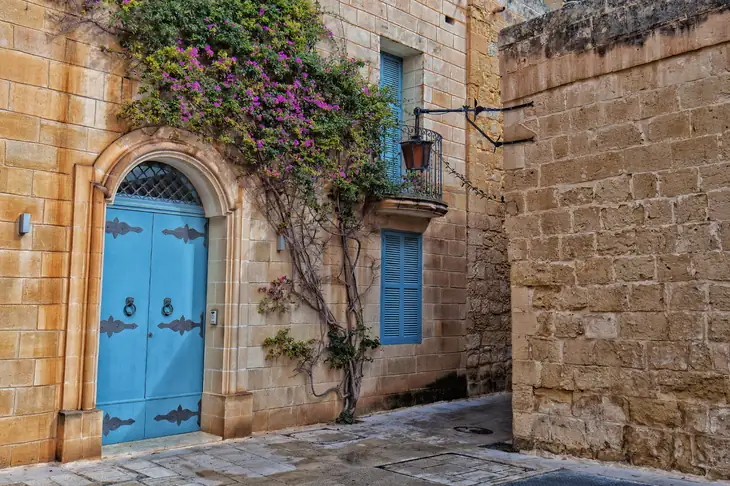
Mdina Blue Door | Image by Arne Dahl on Flickr
Mdina is also a beautiful example of mediaeval and baroque architecture, with its palaces, churches, and bastions. You will enter the city through the impressive Main Gate and wander around the streets and alleys, admiring the views and the buildings.
With the city walls, you can also visit the Mdina Cathedral, the Palazzo Falson, and the Mdina Dungeons, among other attractions.
Have a slice of cake at the famous Fontanella Tea Garden
The Fontanella Tea Garden is a popular and cosy cafe located on the edge of the city walls, with a stunning view of the island.
The cafe is famous for its delicious cakes, especially the chocolate cake, which is a must-try. You can also enjoy a cup of tea, coffee, or hot chocolate and relax in the garden or on the terrace.
See the St. Paul’s Catacombs and the Domus Romana

St. Paul's Catacombs | Image by flowcomm on Flickr
The St. Paul’s Catacombs in Rabat are a complex of underground burial chambers dating back to the Roman and Byzantine periods. They are the largest and best-preserved catacombs in Malta, and they show the diversity and tolerance of the early Christian community. You can see the different types of tombs, the frescoes, and the symbols.
The Domus Romana is a Roman villa just outside the walls of Mdina and was discovered in 1881. It has a well-preserved mosaic floor depicting mythological scenes and a museum that displays Roman artefacts such as pottery, coins, and statues.
Day 3: Discover the Natural Wonders of the North
The north of Malta is the most scenic and natural part of the island, with its sandy beaches, rocky coves, and green countryside. It is also the gateway to the smaller islands of Comino and Gozo, which are worth a visit, and we will plan a day in Gozo later on.
The north of Malta offers a variety of activities and attractions for all tastes and ages, with some highlights being
Take a boat trip to the Blue Lagoon and Comino Island

Blue Lagoon
The Blue Lagoon is a stunning bay with turquoise waters and white sand on the small inhabited island of Comino, which resides between Malta and Gozo. It is one of the most popular and beautiful spots in Malta and a paradise for swimmers, snorkelers, and sunbathers.
You can get to the beach by boat trip from Cirkewwa or Marfa and spend a few hours or a whole day at the Blue Lagoon. You can also explore the rest of Comino, like Santa Maria Bay.
Swim, snorkel, or sunbathe in the crystal-clear waters
The north of Malta has some of the best beaches on the islands, where you can enjoy the sun and the sea. You can choose from the biggest and most popular beaches, such as Mellieħa Bay, Golden Bay, and Għajn Tuffieħa, to smaller ones such as Paradise Bay, Armier Bay, and Gnejna Bay.
You can also find some secluded and hidden spots, such as Fomm ir-Riħ, Slugs Bay, and Mistra Bay. The water is clear and clean, and it has some ideal spots for snorkelling and diving.
Visit the Popeye Village, a film set turned into a theme park
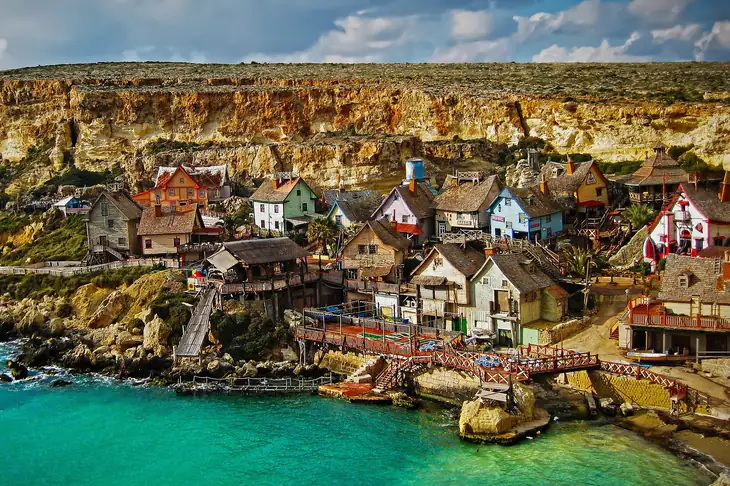
Popeye Village | Image by Callisto_Schmidt from Pixabay
Malta is a popular destination for film and TV show productions. One of these productions that left a legacy on the islands is the 1980 musical film Popeye, starring the late Robin Williams, where the original set has been preserved and transformed into a theme park.
Located at Anchor Bay, near Mellieħa, you can see the wooden houses, the props, and the costumes, and meet the characters of the film. You can enjoy a range of activities, such as boat rides, mini golf, and water trampolines, and have a picnic at the Popeye Village Lido, a beach area with sunbeds and umbrellas.
Hike or bike along the scenic trails of the Dingli Cliffs
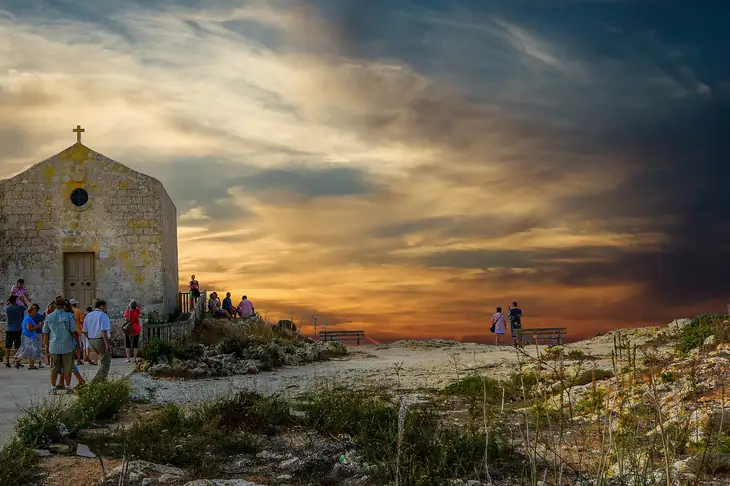
Church Of St Mary Magdalen at Dingli Cliffs | Image by user32212 from Pixabay
The Dingli Cliffs are the highest point in Malta and offer a breathtaking view of the sea and the countryside. They are also a great place for hiking and biking, as there are several trails that run along the edge of the cliffs and through the fields and farms. You can see the small chapel of St. Mary Magdalene, the radar station, and the Buskett Gardens, a woodland area with a variety of plants and animals.
Enjoy a traditional dinner at a farmhouse in Mġarr
Mġarr is a rural village located on the west side of Malta and is known for its agriculture and gastronomy. It is the best place to taste some of the typical dishes of Malta, such as fenek (rabbit), gbejniet (cheeselets), and ħobz biż-żejt (bread with tomato paste and olive oil).
You can find some authentic farmhouses where you can enjoy a hearty and delicious meal in a rustic and friendly atmosphere.
Day 4: Go Back in Time at the Three Cities and Marsaxlokk
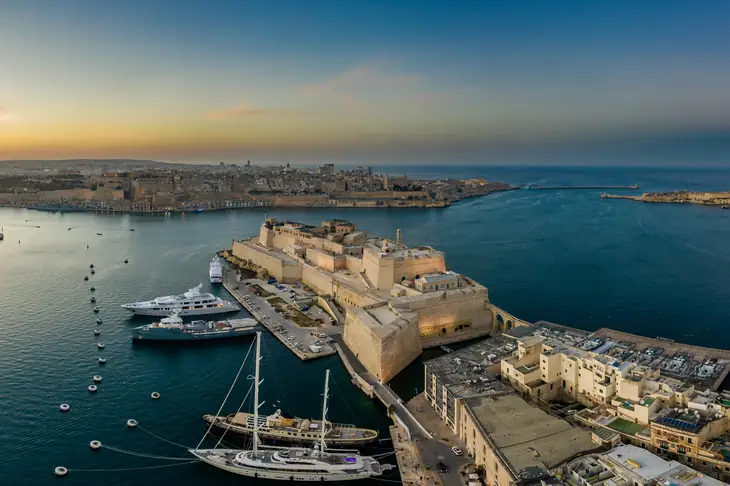
Fort St. Angelo | Image by FritzPhotography on Wikimedia Commons
The Three Cities and Marsaxlokk are two of the most historic and picturesque areas of Malta. The Three Cities have a strong maritime and military heritage. They are composed of Birgu, Senglea, and Cospicua and are also known as Vittoriosa, L-Isla, and Bormla, respectively.
Marsaxlokk is a charming fishing village located in the quite overlooked south part of Malta and is well known for its colourful and lively market and its traditional and authentic vibe.
Here are some of the highlights of the Three Cities and Marsaxlokk:
Visit the oldest settlements in Malta
The Three Cities are a treasure trove of history, culture, and architecture, dating back to Phoenician, Roman, and Arab times. They played a crucial role in the defence of Malta, especially during the Great Siege of 1565, when they resisted the Ottoman invasion.
They are also the birthplace of the Maltese navy and have a strong connection with the sea. You can see the impressive fortifications, the elegant palaces, and the ornate churches that reflect the rich and diverse heritage of the Three Cities.
Learn about the maritime history of Malta at the Malta Maritime Museum and Fort St. Angelo.

Senglea Waterfront | Image by Frank Vincentz on Wikimedia Commons
The Malta Maritime Museum is located in Birgu, in a former naval bakery, and displays a collection of artefacts and models that illustrate the maritime history of Malta, from prehistoric times to modern times.
You can see the largest Roman anchor in the world, the largest ship model in Malta, and the original figurehead of the HMS Hibernia, among other exhibits. The Fort St. Angelo is a mediaeval fortress situated on a promontory overlooking the Grand Harbour. It was the headquarters of the Knights of St. John and the scene of many battles and sieges. You can explore the ramparts, the bastions, the barracks, and the chapel, and enjoy the panoramic view of the harbour and the cities.
The museum will re-open to the public on February 9, 2024.
Take a cruise around the Grand Harbour
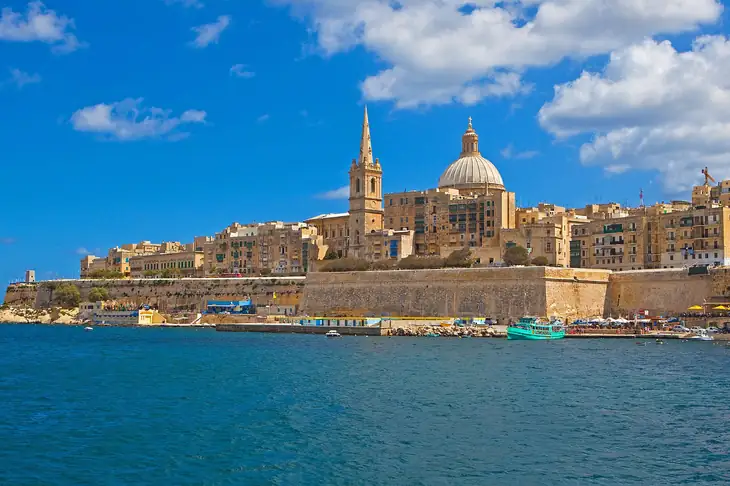
Valletta from the sea | Image by Bengt Nyman on Wikimedia Commons
The best way to appreciate the beauty and magnitude of the fortifications and the Grand Harbour is from the water. You can take a harbour cruise, which is a guided tour that takes you around the harbour and shows you the landmarks and monuments, such as the Fort Ricasoli, the Fort St. Elmo, and the Valletta Waterfront. The cruises usually depart from the Sliema Waterfront and take about 90 minutes.
Another option is to take a ferry that operates between Sliema, Valletta, and the Three Cities. This is an excellent way to get to the Three Cities if you are based in Sliema or St. Julians.
Head to Marsaxlokk, a picturesque fishing village

Luzzu at Marsaxlokk | Image by Alehandra13 from Pixabay
Marsaxlokk is a quaint and charming village, located on a bay, with a fleet of colourful fishing boats, called luzzus, that bob on the water. It is the largest fishing village in Malta and the main source of fresh fish for the island.
You can visit the Marsaxlokk market, which is held every day, but especially on Sundays, and sells fish, seafood, vegetables, fruits, and souvenirs. You can also sample some of the best seafood in Malta at one of the many restaurants that line the waterfront.
You can also see the Marsaxlokk Parish Church, dedicated to Our Lady of Pompeii, and Fort St. Lucian, a 17th-century fort that guards the bay.
Day 5: Immerse Yourself in the Prehistoric and Temporal Heritage of Malta
Malta is one of the oldest and most fascinating countries in the world, with a prehistoric and temporal heritage that is unparalleled and unique. Malta has some of the oldest and most impressive megalithic temples in the world, predating the pyramids of Egypt and the Stonehenge of England.
Malta also has a subterranean necropolis and a cave that reveal the geological and biological evolution of the island.
Here are some of the highlights of the prehistoric and temporal heritage of Malta:
Visit the UNESCO-listed megalithic temples of Ħaġar Qim and Mnajdra

Ħaġar Qim | Image by John Haslam on Flickr
The megalithic temples of Ħaġar Qim and Mnajdra are two of the most ancient and remarkable monuments in Malta, located on a hilltop overlooking the sea and the islet of Filfla. They were built between 3600 and 2500 BC and are made of huge blocks of limestone, carved and arranged in complex patterns and shapes that reflect the astronomical and religious beliefs of their builders.
You can see the altars, the niches, the statues, and the oracle holes that suggest rituals and ceremonies. You can also see the solar alignments that mark the solstices and equinoxes and show the advanced knowledge of the temple builders.
Marvel at the ancient structures and the spectacular views of the sea.
The megalithic temples of Ħaġar Qim and Mnajdra are not only remarkable for their age and their architecture, but also for their location and their scenery. They are situated on a high plateau, surrounded by the Mediterranean Sea and the Maltese countryside.
They offer a stunning view of the horizon, the cliffs, and the islet of Filfla, which is a nature reserve and a bird sanctuary. You can also see the watchtower of Qim, which was built by the Knights of St. John, and the Blue Grotto, a natural cave with azure waters that can be visited by boat.
Discover the subterranean necropolis of the Hypogeum at Hal Saflieni
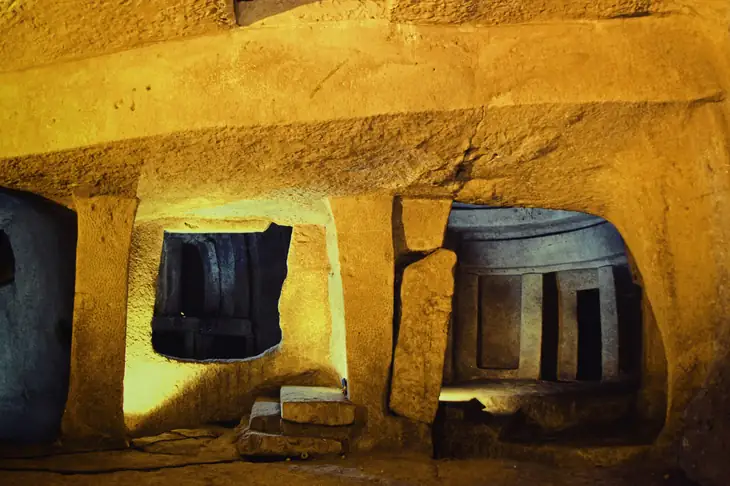
Hypogeum Temple of Hal Saflieni
The Hal Saflieni Hypogeum is a unique and extraordinary site located in Paola, near Tarxien. It is a complex of underground chambers, halls, and passages that were used as a burial place and a cult site by the same civilization that built the megalithic temples.
The Hypogeum is a very popular and sensitive site that can only accommodate a limited number of visitors per day to preserve its environment and conservation.
The tickets are sold online and must be booked well in advance, as they sell out fast. You can book your tickets on the official website of Heritage Malta or through an authorised tour operator. You can also visit the visitor centre, which has a museum, a gift shop, and a cafeteria.
Explore the Tarxien Temples

Tarxien Temples | Image by Kritzolina on Wikimedia Commons
Close to the Hypogeum, one can visit the Tarxien Temples, which are another group of megalithic temples. They were built between 3000 and 2500 BC, and they are the largest and most complex of the temples in Malta.
The temples have four main structures that are connected by walls and courtyards and have elaborate decorations and carvings, such as spirals, animals, and human figures.
Visit the Għar Dalam Cave and Museum

Għar Dalam
The Għar Dalam Cave is a natural and historical attraction located near Birżebbuga, in the south of Malta. The Għar Dalam Cave is a 144-metre-long cave that contains fossils and bones of animals that lived in Malta during the Ice Age, such as dwarf elephants, hippopotamuses, and deer.
At the museum that is on site, you can see the remains of these animals and learn about the geological and biological evolution of the island. The museum has a vast collection of artefacts and exhibits that illustrate the prehistory and early history of Malta, from the Neolithic to the Phoenician periods.
Day 6: Escape to Gozo, the Sister Island of Malta
Another must-do when staying in Malta is to spend a day in Gozo, the second-largest island of the Maltese archipelago. With a population of about 30,000 people, it is a quieter and greener alternative to Malta, with its rolling hills, fertile valleys, and rocky cliffs.
Gozo’s more rural feel gives it a distinct character and charm, with its own history, culture, and traditions. You can reach Gozo through a 20-minute ferry crossing from the port of Cirkewwa in the north of Malta or with the 45-minute fast ferry service that departs from Valletta.
Here are some of the highlights that make a visit to Gozo worth your time.
Explore the Citadel

Citadel | Image by FritzPhotography on Wikimedia Commons
The Citadel is a mediaeval city that dates back to the Bronze Age and has been the centre of power and the refuge of the Gozitans for centuries. It was besieged and captured by the Ottomans in 1551 and rebuilt by the Knights of St. John in the 17th century.
You can enter the citadel through the main gate and walk along the walls and the bastions that offer a panoramic view of the island.
While at the Citadel, you can also visit the Gozo Cathedral, which is the main church of the island and the seat of the bishop of Gozo. It was built in the 17th century on the site of an earlier church that was destroyed by the Ottomans. The cathedral has a baroque facade, a dome, a bell tower, and a neoclassical interior with marble columns, paintings, and statues.
Other attractions at The Citadel include the Folklore Museum, which is located in a cluster of old houses that showcase the traditional life and crafts of Gozo, such as agriculture, fishing, lacemaking, and pottery.
You can also visit the Old Prison, which is located in the lower part of the Citadel and was used as a jail and a court from the 16th to the 20th centuries. You can see the cells, the graffiti, and the exhibits that tell the stories of the prisoners and their crimes.
If all this exploring has made you hungry, make sure you visit Ta’ Rikkardu for some 100% Maltese cuisine.
Visit the Ġgantija Temples

Ġgantija | Image by FritzPhotography on Wikimedia Commons
If you enjoyed your visits to the megalithic temples in Malta, then make sure you don’t miss the Ġgantija Temples. These are among the most ancient monuments in the world. The temples were built between 3600 and 3200 BC by a mysterious civilization that left no written records but only impressive structures and artefacts.
The Ġgantija Temples are accompanied by a museum that provides information and interpretation of the site and the period. The museum has a collection of artefacts and exhibits that showcase the material and spiritual aspects of temple society, such as pottery, tools, jewellery, and figurines.
Head to the Dwejra Bay
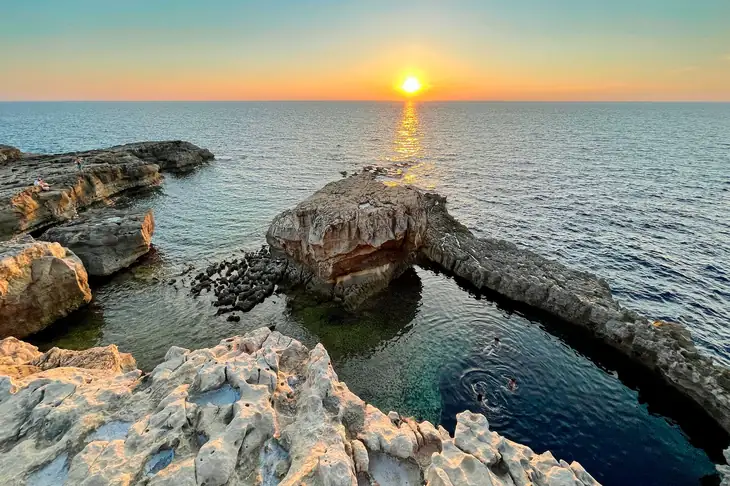
The Blue Hole | Image by Bex Walton on Flickr
Dwejra Bay is a natural and geological wonder located on the west coast of Gozo. It was the site of the Azure Window, a limestone arch that was one of the most iconic landmarks of Malta until it collapsed in 2017 due to natural erosion.
Dwejra Bay is still a beautiful and impressive place where you can admire the natural beauty of the Inland Sea, the Fungus Rock, and the Blue Hole. The Inland Sea is a lagoon of seawater connected to the open sea by a narrow tunnel that can be crossed by boat.
The Fungus Rock is a small islet that was used by the Knights of St. John as a botanical garden, where they grew a rare plant called the Maltese Fungus that had medicinal properties. Finally, the Blue Hole is a circular hole in the rock that leads to a large underwater cave and is a popular spot for diving and snorkelling.
Explore Xerri’s Grotto

Xerri's Grotto | Image by laredawg on Flickr
Anthony Xerri discovered this cave in the 1920s while digging a well beneath a house in Xagħra. During World War II, the cave provided a great safe haven to protect the inhabitants from the constant air raids that battered the island. During this time, the cave underwent extensive excavations.
The cave is home to numerous stalactites and stalagmites in addition to other calcified formations, some of which have the appearance of different animals, including the ear of an elephant, a giraffe, a tortoise, and a vulture. The cave is accessible through a 10-metre (30-foot) spiral that was constructed inside the shaft Anthony Xerri was digging.
Just two minutes’ drive from Xerri’s Grotto lies a similar cave called Ninu’s Grotto.
Day 7: Relax and Enjoy the Maltese Lifestyle
The last day of your itinerary is a day to relax and enjoy the Maltese lifestyle, depending on your preferences and departure time. You can shop for souvenirs and local crafts, relax at one of the beaches or the coves, indulge in some spa treatments or wellness activities, or have a farewell dinner at a Maltese restaurant. Here are some of the options for your last day in Malta:
Indulge in some shopping

Republic Street Valletta | Image by oddpete on Flickr
If you want to buy some souvenirs and local crafts, you can visit the Valletta Market or the Ta’ Qali Craft Village, which are two of the best places for souvenir shopping in Malta.
The Valletta Market is a traditional and lively market that sells a variety of products, such as pottery, lace, jewellery, and food. You can find some unique and handmade items that reflect the culture and identity of Malta.
Ta’ Qali Craft Village, as the name suggests, is an entire village dedicated to local crafts that is home to some of the most renowned, like Mdina Glass.
One can also shop for some local products, which can also make excellent souvenirs. For this, you can also visit one of the many shopping malls that you can find on the island, which houses some of the top local and international brands.
Relax at one of the sandy beaches or the rocky coves of Malta
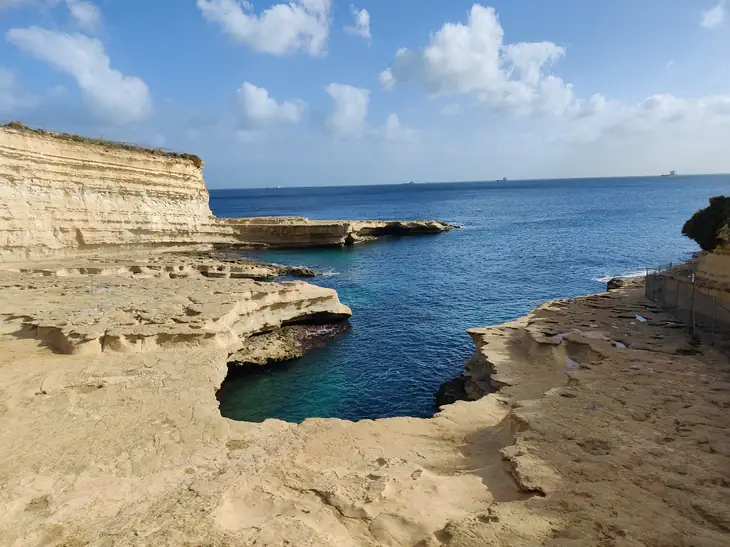
St. Peter's Pool
If you want to relax and enjoy the sun and the sea, you can choose from one of the many beaches and coves that Malta has to offer.
You can opt for a sandy beach, such as Mellieħa Bay, Golden Bay, or Għajn Tuffieħa, or a rocky beach, like St. Peter’s Pool, Il-Kalanka, or Fond Għadir Beach.
Conclusion
Malta is a small nation with a big and diverse personality. It has a rich and varied history, culture, and natural beauty that make it an ideal destination for travellers of all kinds. Whether you are interested in history, culture, nature, or adventure, you will find something to suit your taste and your budget in Malta. You can also enjoy the warm and friendly hospitality of the Maltese people, who will make you feel welcome and at home.
We hope that this seven-day itinerary will help you plan your trip and make the most of your time and money in Malta. We strongly suggest you customise it according to your preferences and budget and add or remove some attractions and activities. If you are travelling with your family, ensure you include one of the many family-friendly attractions available on the island. If you are travelling with a group of friends, make sure you check out the festivals, concerts, and other nightlife activities that happen on the islands.
You can also visit some of our other posts that include tips and resources for booking your accommodation, transportation, and tours, as well as some useful information and advice for travelling in Malta.
We hope that you enjoyed this article and that you are excited to visit Malta. Malta is a wonderful and diverse country that will surprise and delight you with its history, culture, and natural beauty.
Frequently Asked Questions
What languages are spoken in Malta?
Malta has two official languages, Maltese and English, so you will have no problem communicating in English. Most people also speak a third language, with the most common being Italian.
What currency is used in Malta?
Malta official currency is the Euro. Most establishments accept payment using any of the major credit cards, but having some cash handy is highly recommended.
How do I get to Malta?
Malta is well connected by air and by sea, with several flights and ferries from Europe and beyond. You can also get to Malta by sea, as there is a regular service connecting Malta with Sicily.







